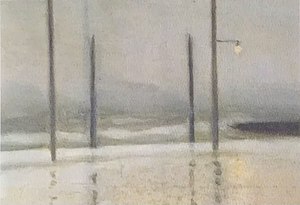

Australian tonalism was an art movement that emerged in Melbourne during the 1910s. Known at the time as tonal realism or Meldrumism, the movement was founded by artist and art teacher Max Meldrum, who developed a unique theory of painting, the "Scientific Order of Impressions". He argued that painting was a pure science of optical analysis, and believed that a painter should aim to create an exact illusion of spatial depth by carefully observing in nature tone and tonal relationships (shades of light and dark) and spontaneously recording them in the order that they had been received by the eye.[1]
Meldrum's followers—among the most notable being Clarice Beckett, Colin Colahan and William Frater—began staging group exhibitions at the Melbourne Athenaeum in 1919.[2] They favoured painting in adverse weather conditions, and often went out together in the morning or towards evening in search of fog and wintry wet surfaces, which provided increased spatial effects. Their subtle, "misty" depictions of Melbourne's beaches and parks, as well as its everyday, unadorned suburbia, show an interest in the interplay between softness and structure, nature and modernity.
The movement peaked during the interwar period, and its lingering influence can be seen in experimental works by other Australian artists, such as Lloyd Rees and Roland Wakelin. Although dismissed by many of their art world contemporaries, today the Australian tonalists are well-represented in Australia's major public art galleries, and are said to have initiated the first significant advance in Australian landscape painting since the Australian impressionists of the 1880s.[3] The minimum of means they used to distill the essence of their subjects has drawn comparisons to the haiku form of poetry, and the movement is regarded as a precursor to the late modernist style minimalism.[3][4][5]
- ^ Meldrum, Max (2008). The science of appearances. Ames, Kenyon R. Frankston South, Vic.: Cinemascope Productions. ISBN 978-0-646-50288-5. OCLC 298654470.
- ^ Perry, Peter W. (1996). Max Meldrum & associates : their art, lives and influences. Castlemaine, Vic.: Castlemaine Art Gallery and Historical Museum. ISBN 0-9598066-7-9. OCLC 38415991.
- ^ a b Cite error: The named reference
essaywas invoked but never defined (see the help page). - ^ Cite error: The named reference
ngawas invoked but never defined (see the help page). - ^ Mclachlan, Scott (2017-04-28). "Presence and the Australian landscape". ART150: Celebrating 150 years of art. Retrieved 2020-11-04.